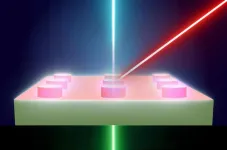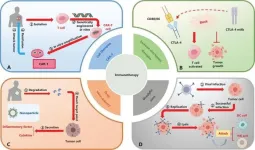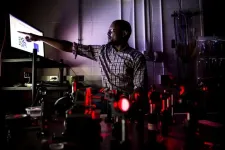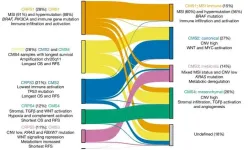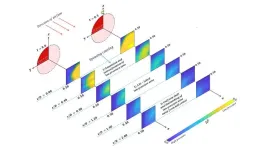(Press-News.org) New research from Memorial Sloan Kettering Cancer Center (MSK) found patients with non-small cell lung cancer brain metastases may benefit from up-front stereotactic radiosurgery; identified a connection between antibiotic use and autoimmune diseases; and uncovered a previously unknown structural role for messenger RNAs in the cytoplasm of cells.
Patients with non-small cell lung cancer brain metastases may benefit from upfront stereotactic radiosurgery
For patients with non-small cell lung cancer that has spread to the brain, targeted therapies called tyrosine kinase inhibitors (TKIs) can be effective at shrinking these tumors. Another treatment for these brain metastases is a type of radiation therapy called stereotactic radiosurgery (SRS), in which powerful and highly targeted radiation is delivered in a focused way to brain metastases, with the help of sophisticated imaging technologies. Traditionally, SRS was the first treatment for brain metastases, but recently there has been a growing trend toward deferring up-front SRS in favor of TKIs. However, these approaches have never been directly compared in a clinical trial.
In a multicenter, retrospective study, a team led by Luke Pike, MD, DPhil, director of brain radiation oncology at MSK, looked at whether giving SRS at the same time as targeted therapy may make treatment more effective. The team reviewed data from 200 patients who received TKIs alone and 117 patients who received TKIs and SRS. They found that although adding SRS to drug treatment did not help patients live longer, it extended the time it took for their disease to progress. This is particularly significant because the patients who got SRS tended to have larger tumors. Based on the findings, the researchers conclude that patients with brain metastases may benefit from having SRS in addition to drug therapy up-front, especially those with larger tumors.
Dr. Pike is now working to initiate a randomized phase 2 clinical trial that will selectively use SRS for patients receiving TKIs that target the EGFR gene — the most commonly altered subtype of non-small cell lung cancer, and one with a high likelihood of spreading to the brain. “Instead of treating all patients up-front, this trial seeks to selectively add SRS to the care of those patients who are likely to be at the highest risk of their brain metastases growing and causing harm, while de-intensifying treatment for most patients,” he says. “We hope that this will result in meaningful improvements in quality of life for our patients living with brain metastases.”
in the Journal of Clinical Oncology.
New evidence for a connection between antibiotic use and autoimmune diseases
Scientists at MSK have uncovered a new connection between depletion of gut bacteria caused by antibiotics and the development of autoimmune diseases. The study, conducted in mouse models, shows that clearance of dead cells — which is necessary for health and the prevention of autoimmune responses — involves not only local signals from within a tissue but also distant signals from other parts of the body, such as the gut. The study looked at mice whose gut bacteria had been depleted by antibiotics and found that immune cells in the abdomen (large peritoneal macrophages) were not clearing out dead cells as well as they should be. When butyrate — a short-chain fatty acid produced by gut bacteria when they breakdown dietary fiber — was given to the mice, it improved the ability of the macrophages to clear out the dead cells. Using a variety of techniques, the team further uncovered key genes and transcription programs involved in the process. They also found that cell clearance remained impaired for a time after the antibiotics were stopped. The study, overseen by immunologist Justin Perry, PhD, a member of the Sloan Kettering Institute and led by postdoctoral fellow Pedro Saavedra, PhD (who now heads a lab at Northeastern University), also looked at the phenomenon in a mouse model of lupus. They found mice treated with antibiotics had significantly worse disease symptoms. Overall, the findings suggest that gut bacteria-produced butyrate and its impact on the body’s ability to clear out dead cells may be a key factor linking antibiotic use to autoimmune disease. in Nature Metabolism.
New research uncovers structural role for messenger RNAs in the cytoplasm
A new study from the lab of Christine Mayr, MD, PhD, at MSK’s Sloan Kettering Institute has unveiled a novel structural role for mRNAs in the cytoplasm. The research introduces the FXR1 network, a messenger RNA-protein network that plays a pivotal role in cellular signaling and organization.
The FXR1 network is formed by FXR1-mediated packaging of exceptionally long messenger RNAs expressed in cells — which are 3-6 times longer than most mRNAs and make up about 10% of the total.
“Think of the FXR1 network as a bustling hub where FXR1 and messenger RNAs interact and help each other to assemble,” says study first author Xiuzhen Chen, PhD, a postdoctoral researcher in the Mayr Lab who received a 2022 Kravis Women in Science Endeavor (WISE) fellowship. “More importantly, signaling proteins that cannot bind RNAs directly get attracted into the network by FXR1. This way, the FXR1 network acts as a hub where signaling proteins can easily find each other.”
The findings show that messenger RNAs do more than just encode proteins, they also serve as structural components that organize signaling reactions in the cell, Dr. Mayr adds. “This discovery opens up new avenues for understanding cellular processes and the molecular basis of diseases like Fragile X Syndrome,” she says.
Mutations in FXR1 are similar to those found in the closely related gene FMR1 that are associated with Fragile X syndrome, a genetic disorder that affects cognitive development, Dr. Mayr notes. These mutations disrupt the FXR1 network and prevent signaling reactions. This disruption highlights the network’s importance in maintaining cellular functions. The principles revealed in the study provide a new path for understanding human diseases stemming from dysfunctional RNA binding proteins by showing that in addition to their well-studied functions, messenger RNAs can also be organizers of signaling reactions. in Cell.
END
MSK Research Highlights, August 13, 2024
2024-08-13
ELSE PRESS RELEASES FROM THIS DATE:
Study finds that dopaminergic medication improves sleep quality in Parkinson’s disease patients
2024-08-13
A study involving 22 Parkinson’s disease (PD) patients has shown that use of the dopaminergic drug levodopa improves sleep quality. When the patients took the drug, the number of times they woke up during the night fell 25% and the amount of time they remained awake fell 30% on average.
The investigation was conducted with FAPESP’s support by researchers at São Paulo State University (UNESP) in Brazil, and the University of Grenoble Alpes (UGA) in France. An article reporting the results is published in ...
Breakthrough in nanotechnology: Viewing the invisible with advanced microscopy
2024-08-13
Tailoring light with Nanomaterials
Metamaterials, engineered at the nanoscale, exhibit unique properties not found in naturally occurring materials. These properties arise from their nanoscale building blocks, which, until now, have been challenging to observe directly due to their size being smaller than the wavelength of light. The team's research overcomes this limitation by employing a new microscopy technique that can simultaneously reveal both the nano and macro structures of these materials.
A New Window into the Nano World
The key finding of this research is a methodological breakthrough that enables the visualization of structures previously too small to be seen ...
Tackling cancer from the inside out: A deep dive into immune checkpoint inhibitors
2024-08-13
In the past two decades, immune checkpoint inhibitors (ICIs) have revolutionized cancer treatment, showing promising results against various solid tumors. This study reviews recent developments in ICIs, focusing on new targets like T cell immunoreceptor with Ig and ITIM domains (TIGIT), T cell immunoglobulin and mucin domain-containing protein 3 (TIM-3), and lymphocyte activation gene-3 (LAG-3). These targets aim to overcome resistance mechanisms limiting the effectiveness of current therapies, such as anti-PD-1 and anti-CTLA-4. By identifying and developing these new ...
RPI Physicist Moussa N’Gom is using light to enhance nuclear security
2024-08-13
Our nation’s security depends on the effective detection of nuclear materials at our borders and beyond. To address this challenge, Rensselaer Polytechnic Institute (RPI) physicist Moussa N’Gom, Ph.D., is leading research aimed at developing a quantum sensing probe to detect and characterize special nuclear materials precisely and without contact. Special nuclear materials are only mildly radioactive but can be used in nuclear explosives.
The research is being conducted through RPI’s participation in the Consortium ...
The atmosphere in the room can affect strategic decision-making, study finds
2024-08-13
The atmosphere within a group can influence the outcome of strategic decision-making, according to a new study co-authored by Bayes Business School (formerly Cass).
Paula Jarzabkowski, Professor of Strategic Management at Bayes, along with researchers from University of Queensland, Macquarie University and Leuphana University of Lüneburg, found that different atmospheres led to people speaking and interacting in different ways that changed how they made sense of the strategy.
For instance, when the atmosphere was pensive, people were cautious about the way to proceed, whereas, when it was curious they felt ...
Study uncovers mutated driver genes in colorectal cancer: 9 novel to CRC and 24 previously undetected in any cancer
2024-08-13
The Institute of Intelligent Medical Research (IIMR) of BGI Genomics, in collaboration with Sweden’s Uppsala University, has published the largest multi-omics study of colorectal cancer (CRC) to date. The study aimed to understand the functional and prognostic impact of cancer-causing somatic mutations, revealing new genetic alterations and developing a new molecular classifier of tumor variants. This research was published in the journal Nature on August 7th, 2024.
Unveiling New Genetic Landscapes
The researchers analyzed the whole genomes and transcriptomes ...
Cricket physics: Science behind the modern bowler technique tricking batters
2024-08-13
WASHINGTON, Aug. 13, 2024 – Key to winning a cricket match is tricking the other team’s batters – no small feat as bowlers bowl cricket balls nearly 100 miles per hour. In recent years, a bowling technique that has become popular involves keeping the arm almost entirely horizontal during delivery, notably used by Sri Lankan stars Lasith Malinga and Matheesha Pathirana. The aerodynamics of such deliveries have perplexed sports physicists.
In Physics of Fluids, by AIP Publishing, researchers have started to unravel the mysteries of how ...
Measuring Martian winds with sound
2024-08-13
WASHINGTON, Aug. 13, 2024 – Mars has a notoriously inhospitable environment, with temperatures that fluctuate dramatically over the course of a Martian day and average minus 80 degrees Fahrenheit. Its surface is mostly covered in red dust, with terrain typified by craters, canyons, and volcanoes. And its atmosphere is extremely thin, comprising only about 1% of the density of Earth’s.
Needless to say, measuring wind speeds on the red planet is challenging. Martian landers have been able capture measurements — some gauging the cooling rate of heated materials ...
Posttraumatic stress disorder and type 2 diabetes outcomes in veterans
2024-08-13
About The Study: The findings of this cohort study of patients with comorbid posttraumatic stress disorder (PTSD) and type 2 diabetes suggest that PTSD is a modifiable risk factor associated with a modest reduction in microvascular complications. Further research is needed to determine whether findings are similar in non-Veterans Health Administration health care settings.
Corresponding Author: To contact the corresponding author, Jeffrey F. Scherrer, PhD, email jeffrey.scherrer@health.slu.edu.
To access the embargoed study: Visit our For The Media website at this link https://media.jamanetwork.com/
(doi:10.1001/jamanetworkopen.2024.27569)
Editor’s ...
Smartwatch measures of outdoor exposure and nearsightedness in children
2024-08-13
About The Study: In this 1-year prospective cohort study of children with smartwatches, continuous outdoor exposure with at least 15 minutes accompanied with no less than 2,000 lux sunlight intensity was associated with less myopic shift. These findings suggest that future outdoor interventions should focus not only on the overall time outdoors but also on the effective outdoor exposure patterns, as a means to effectively prevent myopia (nearsightedness) in children.
Corresponding Authors: To ...

